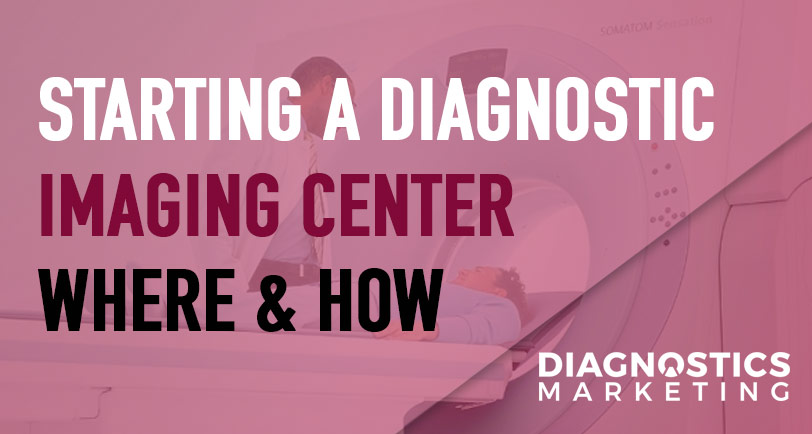There are two important questions to answer relating to starting an imaging center.
The first is: Should you open a diagnostic imaging center? The answer to this one will vary depending on who’s asking it.
The second is perhaps more important and needs to be answered first: What does it take to start an imaging center?
This article is going to give you everything you need to know about building an imaging center so you can come to an informed conclusion on whether or not this endeavor is right for you.
Setting up a marketing strategy for your new imaging center?
Click to read about our diagnostic marketing products and services to grow your center.
Assessing Imaging Center Profitability
Before you start creating a vision and a marketing plan for a new imaging center, you’ll want to do some research. For your radiology center business plan, Imaging center profitability may be on a long-term upward trend, but with healthcare reform and economic changes, there are no guarantees. Is it worth the risk? The only way to answer this is to do the research specific to your situation and location.
Starting an imaging center is not cheap.
You’ll have to put in a lot of money upfront and it can take time to start making a profit. Will you need investors, a business partner, or some loans? Crunching the numbers should be your first step.
Ask Yourself a Lot of Questions
These are dozens of questions you will want to ask yourself in order to determine whether starting an imaging center is a good choice for you. Questions will help guide your research and planning into the financial and marketing aspects of opening an imaging center.
Consider The Location You’re Thinking About Opening an Imaging Center In
The number one rule of all real estate is location, location. location. Sounds easy but there some specific considerations to take into account when we are talking about where to open an imaging center.
Locations near physician’s offices and near the hospital are ideal.
More specifically, your imaging center should be located near the offices of your Referring Physicians. It needs to be accessible and convenient for the patients. Often a physician will recommend a certain test for a patient and tell the patient to come back to his office when it is completed.
Even if a test is not able to be performed immediately or even in the next few days, the patient likely lives or works nearby or at least is familiar with the area.
Pick a location that’s easy to find
If the patient cannot easily locate the radiology imaging center his or her physician recommended, it is the patient’s prerogative to go to any location he or she chooses. Missed appointments mean your radiology marketing budget is taking a hit.
Diagnostics Building Specifications
It is difficult to find a free-standing building that is suitable for all of the requirements for an outpatient imaging center. Even if your chosen building was built as an imaging center, changes will likely have to be made.
It’s up to you to make sure your facility meets all the requirements.
Look and Feel of the Place
Additionally, you’ll want to consider the overall appearance of the center both inside and out. If the building is old and the rooms are cramped, it could steer potential patients and referring physicians away from you.
Parking and Public Transportation to your Imaging Center
There must be enough parking spaces and many patients will need handicapped spaces. If the building is not free-standing, you must be cognizant of the types of businesses above your planned imaging center.
Ideally, your imaging center will be located within easy reach of public transportation. Otherwise, you are limiting your patient pool to those who have a vehicle.
MRI Specific Considerations
 You must carefully consider the ideal location for the MRI room.
You must carefully consider the ideal location for the MRI room.
The MRI machine should be placed in an RF-shielded (radio-frequency) room.
The MRI space consists of three nested components:
- An outer shell for structural support
- A middle metallic RF-shield
- An interior layer made of finish materials
It takes extra space for these items and they must be constructed properly. It can not be too close to moving traffic as that may interfere with the machine’s capabilities.
Steer Clear of ALL METAL
If metal is allowed in the room, catastrophe will ensue. Many times a “foyer” is constructed at the entrance to the MRI room with metal detectors to ensure there are no mistakes.
Consider The Noise of the MRI
The machine is noisy when in use and will possibly be a nuisance to any upstairs or even downstairs neighbors. If your facility is not in a stand-alone building you should assess the possibility of upsetting your neighbors. You also want to take into account any area of your facility that may be sound sensitive and make sure it’s not near any noisy equipment.
Additional MRI Considerations
Depending on where you are, the MRI may have to be a minimum distance away from moving vehicles as well. This includes lawnmowers and trash collection trucks when they are in use.
CT & X-Ray Machines
The x-ray room and the CT room will have to be lead lined. There will be questions about storage and elimination of any chemicals that may be needed for any specialty machines. Newer machines may not be as “hazardous” as older machines so a decision concerning what radiographic machines to purchase may have to be done prior to the final plans for the building.
Installing The Equipment
Remember, the machines to be installed are more often than not very large and very heavy. They will not fit through a doorway. Often the outside wall of the building will have to be removed for the installation, especially for the MRI. After installation, the wall, as well as any required lining, will have to re-installed. The ceiling of the room also will have to be lined.
The Pros Know Best

Start an imaging center: After deliberating and choosing a suitable location for your center, the hard work begins. Even if the building is already built, even as an imaging center, work will have to be done to the premises.
The layout of the facility should be designed by a professional in the area of imaging centers. Dimensions of rooms may vary wildly depending on the footprint of the proposed or existing building.
An MRI requires definitive parameters that a CT exam room or a room for a plain x-ray machine will not need. You’ll need to think about the width of the hallways and the location of the different modalities, as well as the location of the front desk and even the bathrooms.
Think your plans are done? Not till Uncle Sam says so!
After getting the plans drawn and approved by all of the stakeholders involved in the project, the process is just beginning. The county will have its say on the construction or the remodeling of the buildings. There will be details from the building department of your county that may also have specifications for the build of the center. They will go over every aspect in detail. You may think you have thought of every contingency but this is rarely the case.
Where are the exits on the building? Where will the fire extinguishers be placed? Don’t forget about those required pesky water fountains. What about sprinkler heads? Oh no, this may interfere with the MRI machine. You may also have to educate the authorities on the requirements of the machines you will be installing. It can be a difficult and tedious process.
Keeping Your Patients Happy
The entrance to your facility is very important. You need to be sure it makes all patients feel welcome and at ease. Keeping your patients happy also means the look of the interior is crucial. An interior decorator may be utilized to get the perfect “feel” of the imaging center.
Think Beyond The Building

A beautiful facility is a great start, but before you need to think ahead. How will you attract top-notch employees? How can you get 5-star online reviews ethically right out the gate? Established competitors have already considered these points and if you want to succeed you cannot overlook them.
From the start, you should utilize a reputation management system to gather patient experience data and build your positive online reviews. Here’s how to build a positive online reputation right from the start.
Ready to Get Started?
Now that you have your plans in place, the land or building is purchased or at least under contract or option, it is time to begin. You may have thought that getting to this point was difficult but more work, the hard work, is about to begin.
Start an imaging center: Using a Contractor
You may have a contractor or you may have decided to handle the renovations or building yourself. It is not impossible and can be done. By now you know your design inside out. Your contractor should too but it is still your money. If mistakes are made, you are the one who will have to live with them.
Go to the site daily and check on everything.
From the site preparation to the actual building of the imaging center, if the site work is off and needs to be fixed at a later date, you will have to pay for it. Since you’re already paying a pretty penny, you’re not going to want to tack on extra costs because of a misunderstanding. Mistakes can be fixed, but always at a cost, and most often you will have to pay the bill.
Using a Foreman
 If you have decided to be your own contractor, hire a foreman. A good foreman can save you aggravation and money. Not only can he take care of the details, but he should be able to set up an approximate, or definitive timeline for the completion of the work as well as a reliable cost. His knowledge will be invaluable.
If you have decided to be your own contractor, hire a foreman. A good foreman can save you aggravation and money. Not only can he take care of the details, but he should be able to set up an approximate, or definitive timeline for the completion of the work as well as a reliable cost. His knowledge will be invaluable.
Building a Great Staff for your Radiology Center Business Plan
Building a great staff for your imaging center takes time and effort. Consider hiring a chief technologist and let him or her interview prospective employees. If you have chosen well, that person will make a list of individuals they have worked with in the past and will know who is good and who is not. Their judgment may be better than yours in this case.
Don’t wait for your building to be completed to begin this step. Relocating, leaving another job, and upcoming travel can all play a part in when your new employees can start, not to mention training time.
Imaging Center Profitability: Co-ordinate your schedule with the vendors of your equipment.
Your machines should be ready to be installed at the proper time in relation to the building. The realization is that often what the salesman told you and reality may be different. The fact of the matter is that things may have changed over time. You should check and recheck all of the details to make this step as smooth as possible.
Finally, You Are Ready To Open Your Imaging Center
After following this guide to start an imaging center, you’ll be ready to, well, open the place! You overcame a lot to get here, now the real work begins.
Your next big hurdle is to go out there and get the business. Go for it. You can do this!
Have you done your research? Get the knowledge to get ahead!

